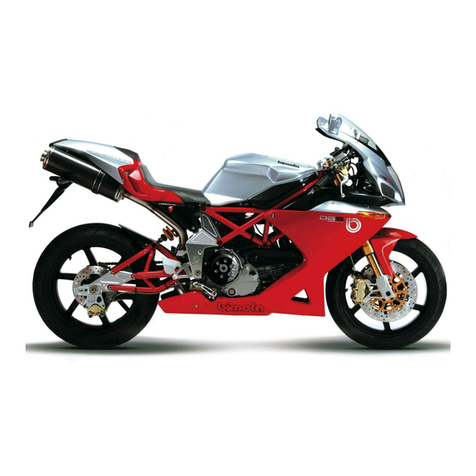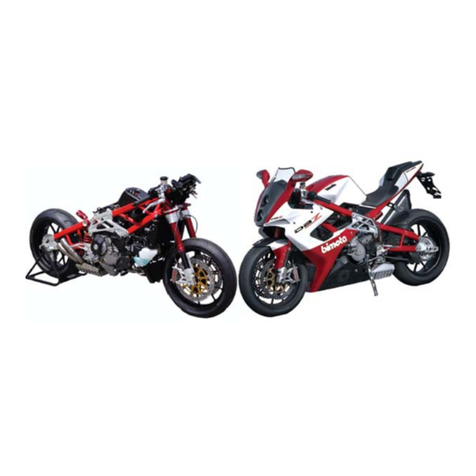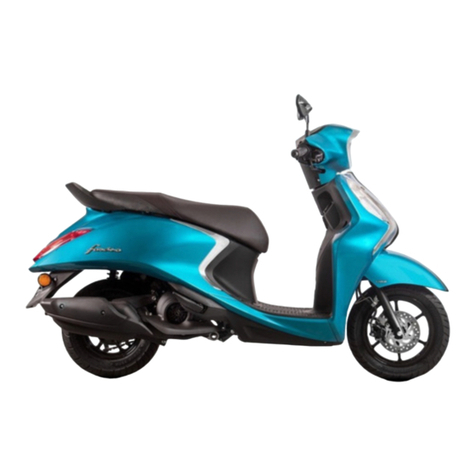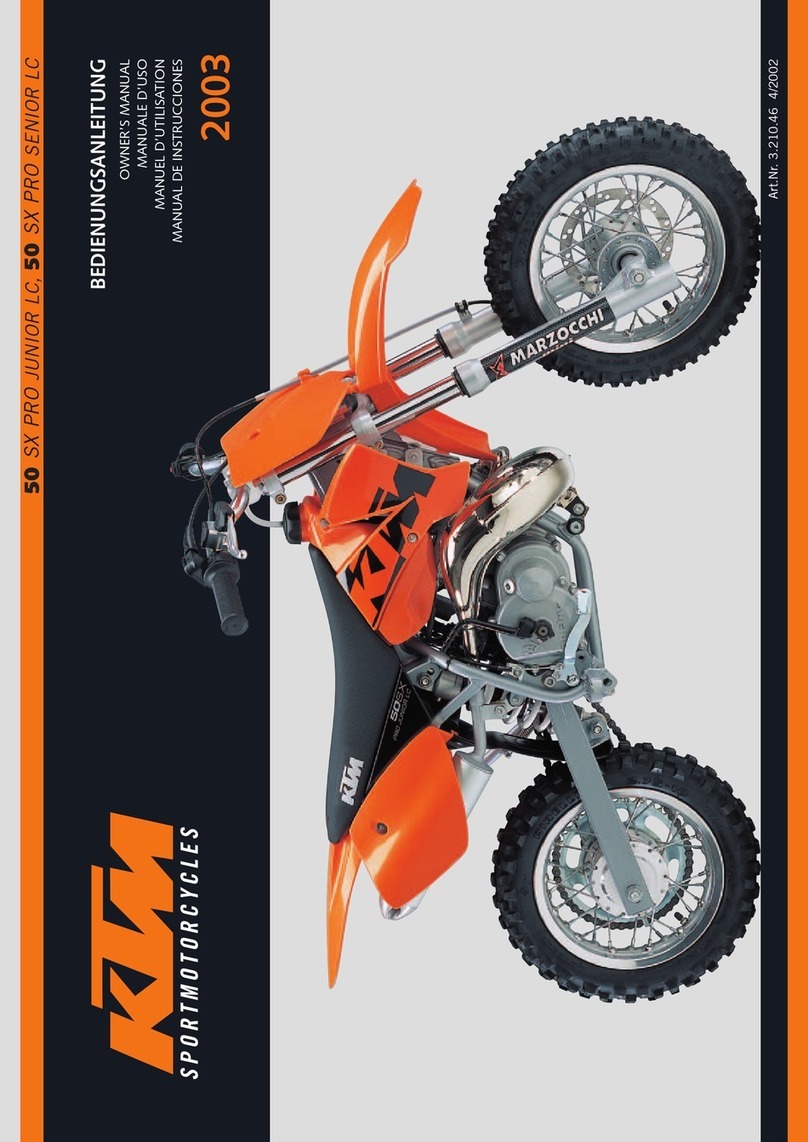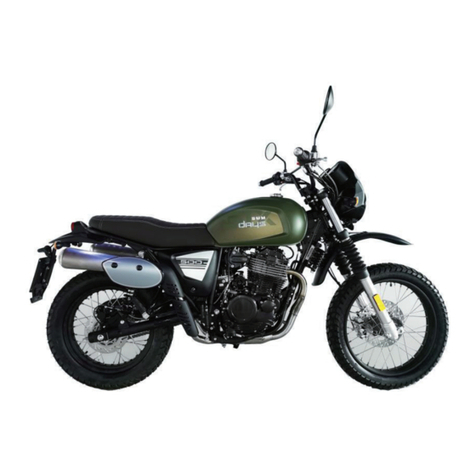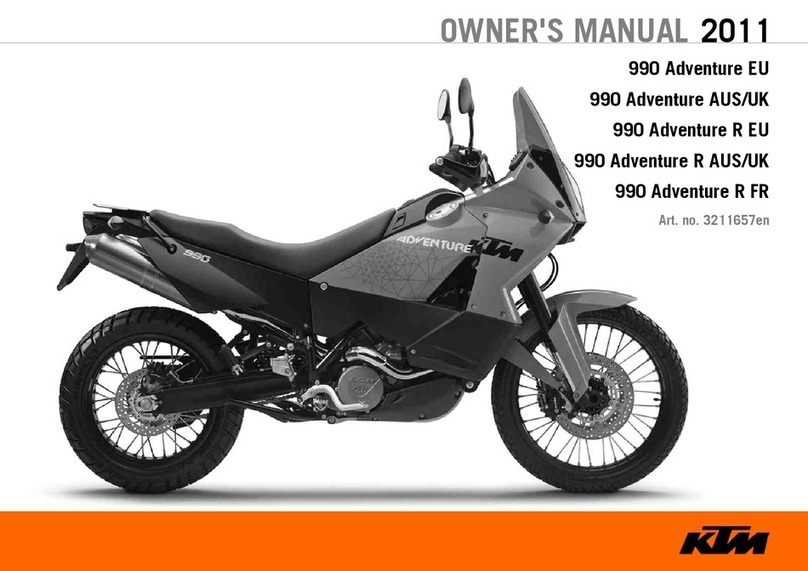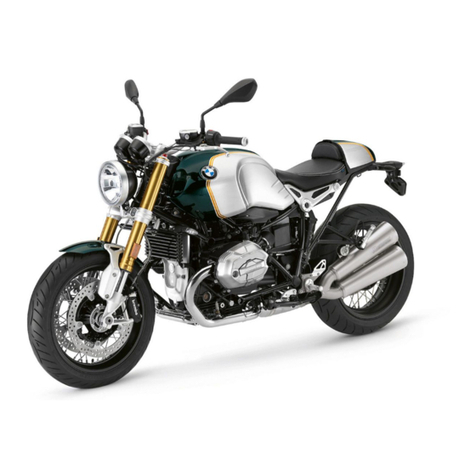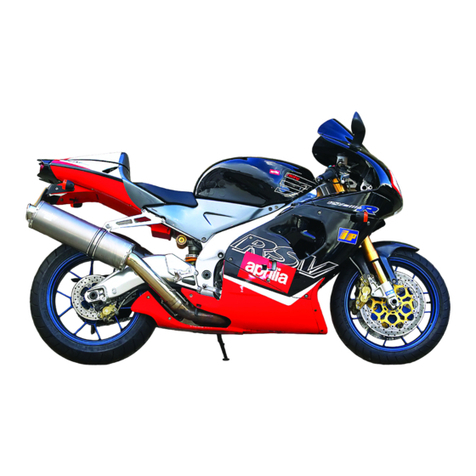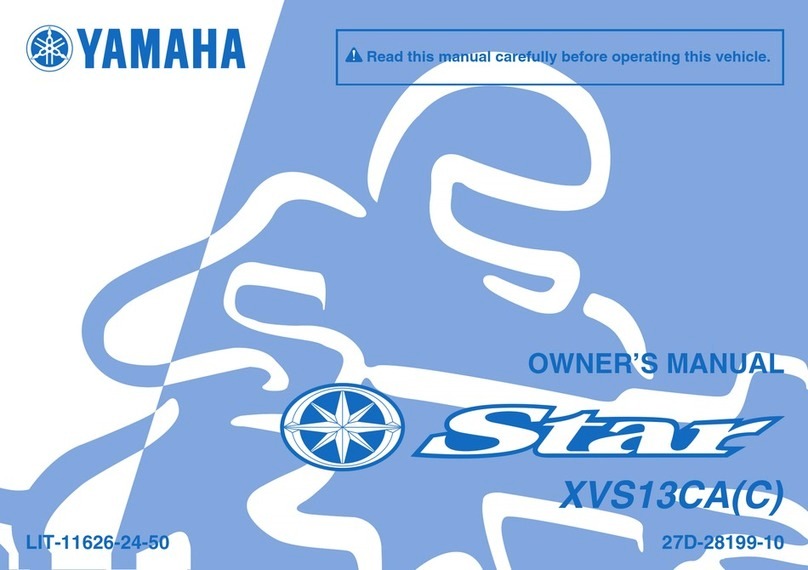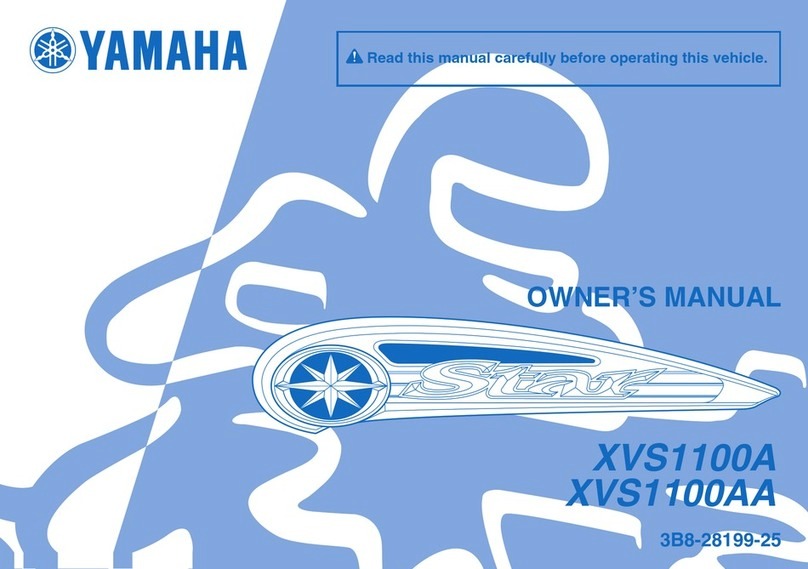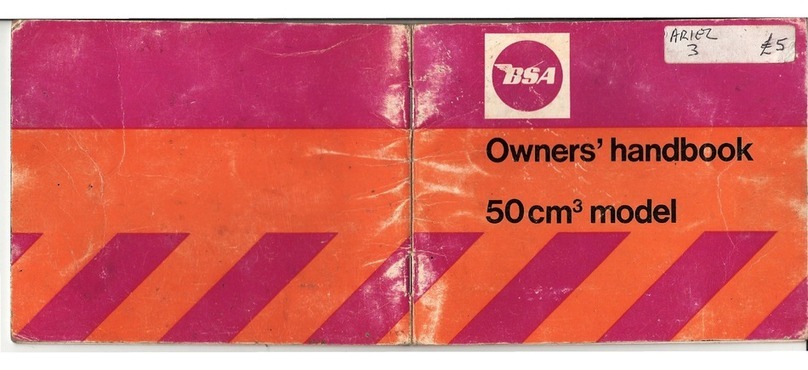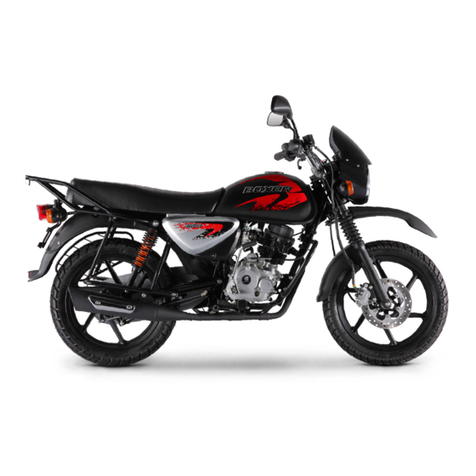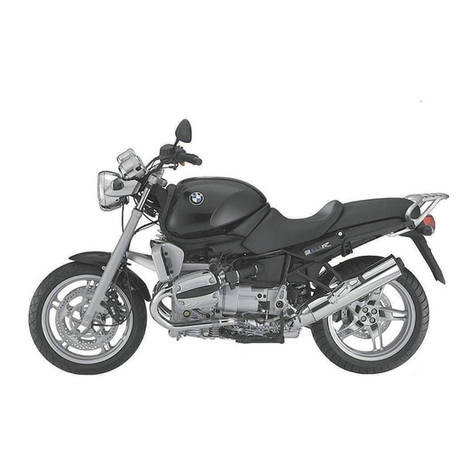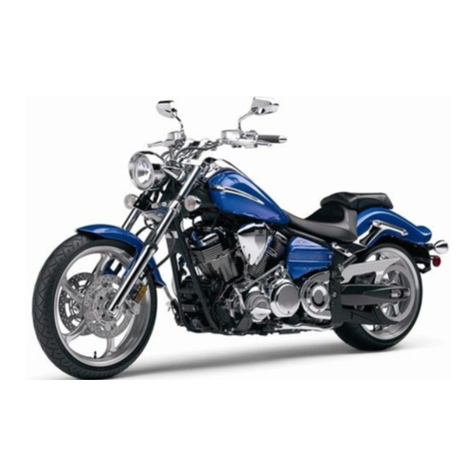bimota KB4 User manual

ENGLISH
Motorcycle
Owner‘s Manual
Rev. 0 del 08/12/2021
Approved : After Sales
Original instructions


Whenever you see the symbols
shown below, heed their instructions!
Always follow safe operating and
maintenance practices.
DANGER
DANGER indicates a hazardous
situation which, if not avoided, will
result in death or serious injury.
WARNING
WARNING indicates a hazardous
situation which, if not avoided, could
result in death or serious injury.
NOTICE
NOTICE is used to address practices
not related to personal injury.
NOTE
æNOTE indicates information that may
help or guide you in the operation or
service of the vehicle.

NOTICE
THIS PRODUCT HAS BEEN
MANUFACTURED FOR USE IN
A REASONABLE AND PRUDENT
MANNER BY A QUALIFIED
OPERATOR AND AS A VEHICLE
ONLY.

Foreword
Congratulations on your purchase of a new Bimota motorcycle. Your new
motorcycle is the product of Bimota’s advanced engineering, exhaustive testing,
and continuous striving for superior reliability, safety and performance.
Please read this Owner’s Manual carefully before riding so that you will be
thoroughly familiar with the proper operation of your motorcycle’s controls, its
features, capabilities, and limitations. This manual oers many safe riding tips, but
its purpose is not to provide instruction in all the techniques and skills required to
ride a motorcycle safely. Bimota strongly recommends that all operators of this
vehicle enroll in a motorcycle rider training program to attain awareness of the
mental and physical requirements necessary for safe motorcycle operation.
To ensure a long, trouble-free life for your motorcycle, give it the proper care and
maintenance described in this manual.
Keep this Owner’s Manual with your motorcycle at all times so that you can refer
to it whenever you need information.
This manual should be considered a permanent part of the motorcycle and should
remain with the motorcycle when it is sold.
All rights reserved. No part of this publication may be reproduced without our
prior written permission.

This publication includes the latest information available at the time of printing.
However, there may be minor dierences between the actual product and
illustrations and text in this manual.
All products are subject to change without prior notice or obligation.
Bimota S.p.a.
© 2021 Bimota S.p.a. Apr. 20, 2021

TABLE OF CONTENTS
SAFETY INFORMATION........................ 11
Read Owner’s Manual ........................ 11
Training ............................................... 11
Daily Checks and Periodic Maintenance .. 11
Loading and Accessories Information ....12
Passenger........................................13
Accessories .....................................14
Other Load.......................................15
If You are Involved in an Accident .......15
Safe Operation ...................................16
Carbon Monoxide Hazard................16
Fueling.............................................17
Never Ride with Drugs or Alcohol ...17
Protective Gear and Clothing...........17
Safe Riding Techniques ..................18
Additional Considerations for High
Speed Operation..............................20
GENERAL INFORMATION.....................22
Specications......................................22
Serial Number Locations ....................26
Location of Labels ..............................27
Location of Parts .................................35
Meter Instruments ..............................38
Speedometer/Tachometer ...............49
Features...........................................50
Control Buttons................................59
Multifunction Display........................60
Multifunction Display Resetting........66
Menu Mode Keys ............................91
Ignition Switch/Steering Lock..............92
Right Handlebar Switches...................94
Left Handlebar Switches ....................95
Brake Lever Adjuster...........................98
Clutch Lever Adjuster .........................99
Fuel ...................................................100
Fuel Requirements .......................100
Filling the Tank ..............................102
Side Stand ........................................105
Seats.................................................105
Footrest.............................................106
Footrest ............................................107
Space for documents .......................108

Event Data Recorder ........................109
HOW TO RIDE THE MOTORCYCLE... 111
Break-In............................................. 111
Starting the Engine ........................... 112
Moving O ........................................ 115
Shifting Gears .................................. 115
Braking.............................................. 117
Anti-lock Brake System (ABS) .......... 118
Bimota Intelligent antilock Brake System
(KIBS)................................................120
Stopping the Engine .........................121
Stopping the Motorcycle in an
Emergency........................................121
Parking..............................................122
Integrated Riding Modes ..................124
Bimota TRaction Control (KTRC)......129
Power Mode .....................................131
Electronic Cruise Control System .....131
Bimota Quick Shift (KQS)..................136
Bimota Cornering Management Function
(KCMF)..............................................137
MAINTENANCE AND ADJUSTMENT..139
Daily Checks ....................................141
Periodic Maintenance .......................144
Engine Oil .........................................148
Coolant .............................................152
Air Cleaner .......................................154
Throttle Control System ...................155
Idle Speed ........................................156
Clutch ...............................................156
Drive Chain ......................................158
Brakes...............................................161
Brake Light Switches ........................163
Suspension System .........................164
Front Fork ......................................164
Rear Shock Absorber.....................167
Setting Tables ...............................169
Wheels .............................................174
Battery ..............................................178
Headlight ..........................................182
Fuses ................................................183
General Lubrication ..........................184
Cleaning............................................185
General Precautions .....................185
Where to be Careful.......................189
Washing Your Vehicle ....................190

APPENDIX ...........................................191
Storage .............................................191
Troubleshooting Guide .....................194
Environmental Protection .................199
Location of DFI System Diagnostic
Connector .........................................200
Vehicle Data Recording ....................200
MAINTENANCE RECORD...................202

SAFETY INFORMATION 11
SAFETY INFORMATION
Read Owner’s Manual
Read this Owner’s Manual carefully
before riding so that you will be
thoroughly familiar with the proper
operation of your motorcycle’s controls,
its features, capabilities, and limitations.
This manual oers many safe riding
tips, but its purpose is not to provide
instruction in all of the techniques and
skills required to ride a motorcycle
safely.
Training
Bimota strongly recommends that
all operators of this vehicle complete
a suitable motorcycle rider training
program to learn the proper skills
and techniques necessary for safe
motorcycle operation.
Daily Checks and Periodic
Maintenance
It is important to keep your
motorcycle properly maintained and
in safe riding condition. Inspect your
motorcycle before every ride and
carry out all periodic maintenance.
See the Daily Checks section and the
Periodic Maintenance section in the
MAINTENANCE AND ADJUSTMENT
chapter for more information.

12 SAFETY INFORMATION
WARNING
Failure to perform these checks or to
correct a problem before operation
may result in serious damage or an
accident. Always perform daily checks
before operation.
To ensure your motorcycle is
serviced using the latest servicing
information, it is recommended that an
authorized Bimota Dealer performs the
periodic maintenance as directed in the
Owner’s Manual.
If you notice any irregular operating
condition, have your motorcycle
thoroughly checked at an authorized
Bimota dealer as soon as possible.
Loading and Accessories
Information
WARNING
Incorrect loading, improper installation
or use of accessories, or modication
of your motor-cycle may result in an
unsafe riding condition. Before you
ride the motorcycle, make sure it is
not overloaded and that you have fol-
lowed these instructions.
Maximum Load
Weight of rider, luggage, and accessories
must not exceed 111 kg (244 lb).
With the exception of genuine Bimota
Parts and Accessories, Bimota has no
control over the design.
In some cases, improper installation
or use of accessories, or motorcycle
modication, will void the motorcycle

SAFETY INFORMATION 13
warranty; can negatively aect
performance, stability and safety; and
can even be illegal.
In selecting and using accessories,
and in loading the motorcycle, you are
personally responsible for your own
safety and the safety of other persons
involved.
NOTE
æBimota Parts and Accessories
have been specially designed for
use on Bimota motorcycles. We
strongly recommend that all parts
and accessories you add to your
motorcycle be genuine Bimota
components.
Because a motorcycle is sensitive to
changes in weight and aerodynamic
forces, you must take extreme care
in carrying cargo, passengers and/or
in tting additional accessories. The
following general guidelines have been
prepared to assist you in making your
determinations.
Passenger
Not allowed

14 SAFETY INFORMATION
Baggage and Luggage
1. All baggage should be carried
as low as possible to reduce the
eect on the motorcycle’s center of
gravity. Baggage weight should also
be distributed equally on both sides
of the motorcycle. Avoid carrying
baggage that extends beyond the
rear of the motorcycle.
2. Baggage should be securely
attached. Make sure that the
baggage will not move around while
you are riding. Recheck baggage
security as often as possible (not
while the motorcycle is in motion)
and adjust as necessary.
Accessories
1. Do not install accessories or
carry baggage that impairs the
performance of the motorcycle.
Make sure that you have not
adversely aected any lighting
components, road clearance,
banking capability (i.e., lean angle),
control operation, wheel travel, front
fork movement, or any other aspects
of the motorcycle’s operation.

SAFETY INFORMATION 15
2. Fairings, windshields, and other
large items have the capability of
adversely aecting stability and
handling of the motorcycle, not only
due to their weight, but also due to
the aerodynamic force acting on
these surfaces while the motorcycle
is in operation. Poorly designed
or installed items can result in an
unsafe riding condition. Lugs are
provided on the swingarm to attach
accessory rear stand adaptors.
Other Load
1. This motorcycle is not intended
to be equipped with a sidecar or
to be used to tow any trailers or
other vehicles. Bimota does not
manufacture sidecars or trailers
for motorcycles and cannot predict
the eects of such accessories on
handling or stability, but can only
warn that the eects can be adverse
and that Bimota cannot assume
responsibility for the results of such
unintended use of the motorcycle.
2. Furthermore, any adverse eects on
motorcycle components caused by
the use of such accessories will not
be remedied under warranty.
If You are Involved in an
Accident
Make sure of your own safety rst.
Determine the severity of any injuries
and call for emergency assistance if
needed. Always follow applicable laws
and regulations if any other person,
vehicle or property is involved.
Do not attempt to continue
riding without rst evaluating your
motorcycle’s condition. Inspect for

16 SAFETY INFORMATION
uid leaks, check critical nuts and
bolts, and check the handlebars,
control levers, brakes, and wheels
for damage and proper function. Ride
slowly and cautiously - your motorcycle
may have suered damage that is
not immediately apparent. Have your
motorcycle thoroughly checked at
a Bimota dealer as soon as possible.
Safe Operation
The following should be carefully
observed for safe and eective vehicle
operation.
Carbon Monoxide Hazard
DANGER
Exhaust gas contains carbon
monoxide, a colorless, odorless
poisonous gas. Inhaling carbon
monoxide can cause serious brain
injury or death. DO NOT run the
engine in enclosed areas. Operate
only in a well-ventilated area.

SAFETY INFORMATION 17
Fueling
WARNING
Gasoline is extremely ammable
and can be explosive under certain
conditions.
To avoid a possible re or explosion,
turn the ignition switch o. Do not
smoke. Make sure the area is well
ventilated and free from any source
of ame or sparks; this includes any
appliance with a pilot light.
Never Ride with Drugs or Alcohol
Alcohol and drugs impair your
judgment and reaction time. Never
consume alcohol or drugs before or
while riding motorcycles.
Protective Gear and Clothing
Helmet
Bimota strongly recommends the
operator wear a helmet even if this is
not a legal requirement.
- Make sure that your helmet ts
correctly and is properly fastened.
- Choose a motorcycle helmet
that meets the safety standards
applicable to your country. Ask your
motorcycle dealer to advise you if
necessary.
Eye Protection
Always use eye protection. If your
helmet does not have a visor installed,
wear goggles.

18 SAFETY INFORMATION
Gloves
Wear gloves which have suitable
protection for your hands, especially
against abrasion.
Clothing
Wear the riding wear which have
protectors for each parts of the body
(chest, shoulders, back, elbows and
knees, etc.) as much as possible, or
wear protectors for them.
- Always wear a long-sleeved
jacket and long trousers which are
abrasion resistant and keep you
warm.
- Wear clothing that allows freedom
of movement.
- Avoid wearing clothes which have
loose cus or other fastenings which
could interfere with the controls of
your motorcycle.
- Wear bright, highly visible clothing.
Boots
Wear proper protective boots that t
properly and do not interfere with gear
shifting or braking.
Safe Riding Techniques
Keep Hands on Handlebars
When riding always keep both hands
on the handlebars and both feet on the
foot pegs. Removing your hands from
the handlebars or feet from the foot
pegs while riding can be hazardous.
If you remove even one hand or foot,
you reduce your ability to control the
motorcycle.
Look Over Your Shoulder
Before changing lanes, look over
your shoulder to make sure the way
is clear. Do not rely solely on the
rear view mirror; you may misjudge
a vehicle’s distance and speed, or you
may not see it at all.

SAFETY INFORMATION 19
Accelerate and Brake Smoothly
In general your actions should
be smooth as sudden acceleration,
braking or turning may cause loss of
control, especially when riding in wet
conditions or on loose road surfaces,
when the ability to maneuver will be
reduced.
Select Correct Gear Speeds
When going up steep slopes, shift
to a lower gear so that there is power
to spare rather than overloading the
engine.
Use Both Front and Rear Brakes
When applying the brakes, use both
the front and rear brakes. Applying
only one brake for sudden braking may
cause the motorcycle to skid and lose
control.
Use Engine Brake
When going down long slopes, help
control vehicle speed by closing the
throttle so that the engine can act as an
auxiliary brake. Use the front and rear
brakes for primary braking.
Riding in Wet Conditions
Rely more on the throttle to control
vehicle speed and less on the front and
rear brakes. The throttle should also be
used judiciously to avoid skidding the
rear wheel from too rapid acceleration
or deceleration.
Braking performance is also reduced
in wet conditions. Carefully ride at
a slow speed and apply the brakes
several times to help dry and restores
them to normal operating performance.
Lubricate the drive chain after wet
weather riding to prevent rust and
corrosion.
Ride Prudently
Riding at the proper speed
and avoiding unnecessarily fast

20 SAFETY INFORMATION
acceleration are important not only for
safety and low fuel consumption but
also for long vehicle life and quieter
operation.
Riding on Rough Roads
Exercise caution, slow down, and
grip the fuel tank with the knees for
better stability.
Acceleration
When quick acceleration is necessary
to pass another vehicle, shift to a lower
gear to obtain the necessary power.
Downshifting
To avoid engine damage and rear
wheel lock-up do not down shift at high
rpm.
Avoid Unnecessary Weaving
Unnecessary weaving jeopardizes
the safety of both the rider and other
motorists.
Additional Considerations for High
Speed Operation
WARNING
Handling characteristics of
a motorcycle at high speeds may
vary from those you are familiar
with at legal highway speeds. Do
not attempt high speed operation
uness you have received sucient
training and have the required skills.
Do not operate at high speeds on
public roads.
Table of contents
Other bimota Motorcycle manuals

